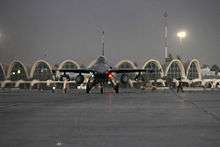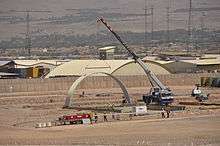Train Advise Assist Command – South
| Train Advise Assist Command – South (TAAC – South) | |
|---|---|
| Role | Training |
| Garrison/HQ | Kandahar Airfield |
| Website | TAAC – South |
| Commanders | |
| Current commander | Brig. Gen. Lee Henry (USA) |
Train Advise Assist Command – South (TAAC – South) is a multinational military formation, part of NATO's Resolute Support Mission within Afghanistan. It is the former Regional Command South of the International Security Assistance Force (ISAF).
It is responsible for provincial reconstruction and security in Zabul, Kandahar, Daykundi, and Uruzgan Province. Its primary Afghan National Army partner is the 205th Corps. NATO countries contributing troops are Albania, Canada, France, Netherlands, Romania, Slovakia, the United Kingdom, and the United States. Non-NATO countries contributing troops are Australia, New Zealand, and Singapore.
History
Command

The command of the region previously rotated between Canada, the Netherlands, and the United Kingdom, but has most recently been assumed solely by the United States. The headquarters is located at Kandahar International Airport next to the city of Kandahar. In 2010, the command's original territory was split into two commands, with the new Regional Command Southwest headquartered in Helmand Province.[1]
- 28 February 2006: Canadian Brigadier-General David Fraser assumed Command of Regional Command South.
- 1 November 2006: Dutch Major-General Ton van Loon led Regional Command South in Afghanistan for a six months period.[2]
- 1 May 2007: British Major-General Jacko Page
- 1 February 2008: Canadian Major-General Marc Lessard took command for a nine-month period.
- 1 November 2008: the Dutch Major-General Mart de Kruif took command of this region.
- 1 November 2009: British Major General Nick Carter took command.[3] At this time, 6 (UK) Division, reorganised as Combined Joint Task Force 6, took over the headquarters function for the period of the British rotation. On 14 June 2010, RC(S) was split to create RC(S) and RC(SW). RC(SW) assumed control of the Helmand and Nimroz provinces.
- 1 November 2010: USA Major General James L. Terry, Commanding General, 10th Mountain Division, assumes command of Regional Command South. Headquarters 10th Mountain Division (LI) became HQ Combined Joint Task Force 10 for the deployment.
- 1 October 2011: USA Major General James L. Huggins,[4] Commanding General, 82nd Airborne Division, assumes command of Regional Command South.
- 2 September 2012: Major General Robert B. Abrams, Commanding General, 3rd Infantry Division, U.S. Army, assumes command of Regional Command South. The 3rd Infantry Division became Combined Joint Task Force 3 for the deployment.[5]
- 8 July 2013, USA Major General Paul LaCamera, Commanding General, 4th Infantry Division, assumes command of RC-S. Headquarters 4th Infantry Division became HQ Combined Joint Task Force 4 for the deployment.
- 7 July 2014, USA Major General Michael Bills, Commanding General, 1st Cavalry Division, assumes command of RC-S. Headquarters 1st Cavalry Division became HQ Combined Joint Task Force 1 for the deployment.
- 14 Oct 2014, USA Brigadier General Douglas Gabram, Commanding General, CJTF-1 of the 1st Cavalry Division, assumes responsibility for Train, Advise, Assist Command - South (TAAC-S), CJTF-1. At this time RC(S) became TAAC-S.[6]
- 10 January 2015, USA Brigadier General Viet Luong, Commanding General, CJTF-1 of the 1st Cavalry Division, assumes responsibility for TAAC-S.[7]
- 10 June 2015, USA Brigadier General Paul Bontrager, Commanding General, CJTF-7 (TF Bayonet) of the 7th Infantry Division, assumes responsibility for TAAC-S.[8]
- 26 October 2015, USA Brigadier General Antonio Aguto, Commanding General, CJTF-7 (TF Bayonet) of the 7th Infantry Division, assumes responsibility for TAAC-S.
- 22 June 2016, USA Brigadier General Lee Henry, Commanding General, CJTF-36 (TF Arrowhead) of the 36th Infantry Division, assumes responsibility for TAAC-S. This is the first time a National Guard division command element has assumed responsibility for a regional command within Afghanistan.[9]
Major Units

- HQ RC(S) at Kandahar International Airport in Kandahar Province, consisting of the 4th Infantry Division's divisional headquarters[4]
- Combined Task Force Spartan, U.S. Army's 1st Brigade Combat Team, 10th Mountain Division, Zhari and Maywand Districts of Kandahar Province[10]
- Combined Task Force Warhorse, U.S. Army's 2nd Brigade Combat Team, 4th Infantry Division, Kandahar City[10]
- Task Force Viper, U.S. Army's 504th Battlefield Surveillance Brigade, southeastern Kandahar Province[10]
- Combined Team Uruzgan, Australian Mentoring Task Force Number 2, Uruzgan Province[10]
- Combined Team Zabul, U.S. Army National Guard's 116th Infantry Brigade Combat Team, 29th Infantry Division, Zabul Province[10]
- Task Force Arctic Wolves, U.S. Army's 1st Stryker Brigade Combat Team, 25th Infantry Division, Panjwa'i, Dand, and Daman districts of Kandahar Province[10]
- Task Force Thunder, U.S. Army's 159 Combat Aviation Brigade, 101st Airborne Division, responsible for rotary-wing aviation in Regional Command South[10]
- 451st Air Expeditionary Wing, U.S. Air Force, provides fixed-wing aviation support[10]
Provincial Reconstruction Teams
Three Provincial Reconstruction Teams (PRTs) operate in Regional Command South: Kandahar PRT, Kandahar province, led by the United States; Qalat PRT, Zabul province, led by the U.S. and supported by Romania and the U.K.; and Tarin Kot PRT, Uruzgan province, led by Australia.[10]
Current use
Command
- Brig. Gen. Lee Henry (USA) from June 2016.
Major units
- Task Force Mountain Warrior: U.S. 4th Infantry Brigade Combat Team, 4th Infantry Division
- Task Force Corsair: U.S. 2nd Battalion, 82nd Aviation Regiment
- 205th CAT
- Police Advisory Team
- 451st Air Expeditionary Wing
See also
- Train Advise Assist Command – Capital
- Train Advise Assist Command – North
- Train Advise Assist Command – East
- Train Advise Assist Command – West
- Train Advise Assist Command – Air
References
- ↑ "Command and control changes in southern Afghanistan". Ministry of Defence. 21 May 2010.
- ↑ Major-General Ton van Loon
- ↑ UK Ministry of Defence
- 1 2 Major General James L. Huggins (USA)
- ↑ http://www.army.mil/article/88250/3rd_Infantry_Division_takes_command_of_Regional_Command_South/
- ↑ https://www.army.mil/article/136094/RC_South_transitions_to_TAAC_South_in_ceremony_at_KAF/
- ↑ .https://www.army.mil/article/141273/U_S__Train__Advise__Assist_Command___South_changes_leadership/
- ↑ http://www.rs.nato.int/article/rs-news/7th-infantry-division-assumes-responsibility-of-taac-s.html/
- ↑ http://www.airborneangelcadets.com/2016/06/texas-army-national-guard-takes.html/
- 1 2 3 4 5 6 7 8 9 Regional Command South
External links
| Wikimedia Commons has media related to Train Advise Assist Command – South. |